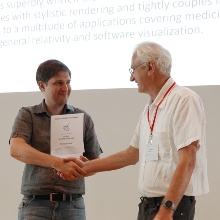At this year’s EuroVis conference, VISUS researcher Christoph Schulz received the EuroVis PhD Award for his dissertation “Uncertainty-aware Visualization Techniques”. Congratulations! The EuroVis PhD Award is granted for outstanding dissertations on visualization-related topics to recognize excellent young researchers in their early career and to highlight visualization research. The award ceremony took place during the conference in Leipzig.
Dissertation Abstract
Nearly all information is uncertainty-afflicted. Whether and how we present this uncertainty can have a major impact on how our audience perceives such information. Still, uncertainty is rarely visualized and communicated. One difficulty is that we tend to interpret illustrations as truthful. For example, it is difficult to understand that a drawn point’s presence, absence, and location may not convey its full information. Similarly, it may be challenging to classify a point within a probability distribution. One must learn how to interpret uncertainty-afflicted information. Accordingly, this thesis addresses three research questions: How can we identify and reason about uncertainty? What are approaches to modeling flow of uncertainty through the visualization pipeline? Which methods are suitable for harnessing uncertainty? The first chapter is concerned with sources of uncertainty. Then, approaches to model uncertainty using descriptive statistics and unsupervised learning are discussed. Also, a model for validation and evaluation of visualization methods is proposed. Further, methods for visualizing uncertainty-afflicted networks, trees, point data, sequences, and time series are presented. The focus lies on modeling, propagation, and visualization of uncertainty. As encodings of uncertainty, we propose wave-like splines and sampling-based transparency. As an overarching approach to adapt existing visualization methods for uncertain information, we identify the layout process (the placement of objects). The main difficulty is that these objects are not simple points but distribution functions or convex hulls. We also develop two stippling-based methods for rendering that utilize the ability of the human visual system to cope with uncertainty. Finally, I provide insight into possible directions for future research.


